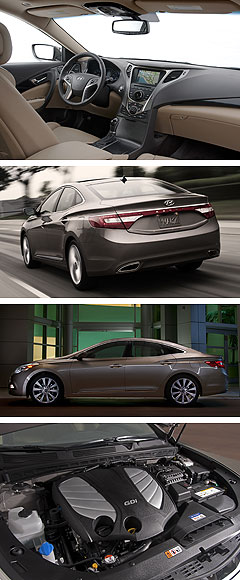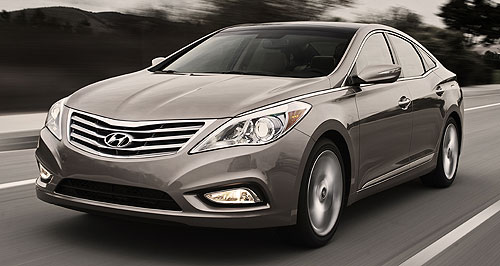Make / Model Search
Future models - Hyundai - AzeraLA show: Hyundai rolls out big, brassy AzeraFluid metal: Hyundai’s Azera provides another interpretation of the ‘fluidic sculpture’ design ethos, and also debuts a new 3.3-litre ‘Lambda II’ GDI V6. Still no Grandeur for Oz but Hyundai’s latest large car hits US with new 3.3 V6 GDI17 Nov 2011 By TERRY MARTIN HYUNDAI has launched its new-generation Azera large sedan – the North American version of the Korean manufacturer’s latest Grandeur – at the Los Angeles auto show this week ahead of its North American showroom debut in the first quarter of 2012. The luxuriously appointed four-door has been on sale in Korea since earlier this year but remains off the agenda for sale in Australia, with Hyundai Motor Co Australia deciding against committing to the new generation after the previous model was discontinued due to slow sales. Despite significant advancements in styling, safety and technology with the all-new Azera, the Australian subsidiary has put its weight behind the burgeoning i45/i40 medium-size range and this week reasserted its commitment to introducing the redesigned large-size Genesis Coupe when it becomes available in the next couple of years. HMCA senior manager for PR and events Ben Hershman told GoAuto the company had no plans to introduce the new Azera/Grandeur here, and buried suggestions there were moves afoot to introduce a Genesis luxury brand in Australia. Although a new-generation Genesis sedan – to be bigger than the Grandeur – is being developed in conjunction with the two-door model, the Australian-bound coupe is at this stage expected to be a standalone model from launch. “Australia is not taking the new Grandeur,” said Mr Hershman.  “Genesis is not a separate sub-brand within Hyundai and there are no plans to create one. “Hyundai has only confirmed that Genesis Coupe will be developed in right-hand drive in its next generation and will come to Australia. An introduction timeframe for this model is not yet known. “It is too early to comment on the launch strategy for the next-generation Genesis Coupe in the Australian market.” Significantly, the US Azera has emerged with a new 3.3-litre 24-valve ‘Lambda II’ V6 engine with Dual-CVVT (Dual Continuously Variable Valve Timing) and Hyundai’s GDI direct-injection system. The new engine produces 218kW of power and 346Nm of torque to set up a claimed best-in-class specific output of 66.2kW per litre and, according to Hyundai, beat a host of big-name rivals including the Ford Taurus, Buick LaCrosse, Lexus ES350, Acura TL, Toyota Avalon and Nissan Maxima. The small displacement of 3342cc contributes here, along with the high-pressure direct-injection system (2200-plus psi) that Hyundai says increases power and torque while at the same time reducing fuel consumption and emissions. Combined-cycle fuel economy is 10.2 litres per 100km for the vehicle, which has a kerb weight of around 1735kg and is fitted standard with an in-house six-speed automatic transmission with ‘Shiftronic’ sequential-manual operation. Also included is an ‘Active Eco’ mode which modifies engine and gearbox control for a claimed five per cent improvement in real-world fuel economy. The all-aluminium engine, which has a high compression ratio of 11.5:1, could find its way to Australia in other models, such as the Santa Fe SUV, which currently relies on a 204kW/335Nm 3.5-litre V6 for its petrol power. A 2.2-litre CRDi diesel is also available. Other markets offer a 183kW 3.0-litre Lambda V6 engine and a 132kW 2.4-litre Theta four-cylinder engine, both with Dual-CVVT. The fifth vehicle in North America to adopt the company’s signature ‘fluidic sculpture’ design language – after Tucson, Accent, Elantra and Sonata – the Azera rests on a 2845mm wheelbase and measures 4910mm in overall length, 1860mm in width and 1470mm in height. The front seating area offers 1025mm headroom and 1155mm legroom – said to be best-in-class dimensions – plus 1480mm shoulder room, while the rear compartment offers 962mm headroom, 935mm legroom and 1432mm shoulder room. Nine airbags, including a driver’s knee airbag, are fitted standard in the US Azera, along with a host of accident-avoiding systems including Vehicle Stability Management, ESC and ABS brakes with EBD and brake assist. Hyundai has also developed an ‘impact-reducing’ seat system with an optimised seatback structure that eliminates the need for anti-whiplash front head restraints and is “expected to reduce head and neck injuries by 17 per cent over the front seats in the previous-generation Azera, which had active front head restraints”. Other notable features include Xenon headlights with LED accents, standard 18-inch wheels (with optional 19-inch units), a rear-view camera, electro-chromatic mirrors, heated leather front and rear seats, Bluetooth with voice recognition, iPod/USB/aux inputs, seven-speaker CD/MP3 audio, telematics platform, side window sunshades, dual-zone climate-control air-conditioning, touch-screen satellite-navigation, carbon interior accents, ambient lighting and an optional panoramic sunroof. The Azera uses a MacPherson strut front and multi-link rear suspension, aided by Sachs Amplitude Selective Dampers, and an electric power steering system. The chassis set-up is said to enable “precise geometry for a premium ride and engaging handling prowess”.  Read more16th of November 2011  More power for Hyundai’s Genesis CoupeFacelifted Genesis Coupe packs more punch as Hyundai Oz waits for next generationAll motor show Alfa Romeo Alfa Romeo Abarth Abarth Alpine Alpine Alpina Alpina Audi Audi Aston Martin Aston Martin BMW BMW Bentley Bentley Chery Chery Brabham Brabham Chrysler Chrysler Chevrolet Chevrolet Cupra Cupra Citroen Citroen DS DS Dodge Dodge Fiat Fiat Ferrari Ferrari Foton Foton Ford Ford Great Wall Great Wall FPV FPV Haval Haval GWM GWM Honda Honda Holden Holden Hummer Hummer HSV HSV Infiniti Infiniti Hyundai Hyundai Jaguar Jaguar Isuzu Isuzu Kia Kia Jeep Jeep Land Rover Land Rover Lamborghini Lamborghini Lexus Lexus LDV LDV Mahindra Mahindra Lotus Lotus Mazda Mazda Maserati Maserati Mercedes-AMG Mercedes-AMG McLaren McLaren MG MG Mercedes-Benz Mercedes-Benz Mitsubishi Mitsubishi Mini Mini Opel Opel Nissan Nissan Peugeot Peugeot Pagani Pagani Proton Proton Porsche Porsche Renault Renault Ram Ram Rover Rover Rolls-Royce Rolls-Royce Skoda Skoda Saab Saab SsangYong SsangYong Smart Smart Suzuki Suzuki Subaru Subaru Toyota Toyota Tesla Tesla Volvo VolvoMotor industry news |
Click to shareAll motor show Alfa Romeo Alfa Romeo Abarth Abarth Alpine Alpine Alpina Alpina Audi Audi Aston Martin Aston Martin BMW BMW Bentley Bentley Chery Chery Brabham Brabham Chrysler Chrysler Chevrolet Chevrolet Cupra Cupra Citroen Citroen DS DS Dodge Dodge Fiat Fiat Ferrari Ferrari Foton Foton Ford Ford Great Wall Great Wall FPV FPV Haval Haval GWM GWM Honda Honda Holden Holden Hummer Hummer HSV HSV Infiniti Infiniti Hyundai Hyundai Jaguar Jaguar Isuzu Isuzu Kia Kia Jeep Jeep Land Rover Land Rover Lamborghini Lamborghini Lexus Lexus LDV LDV Mahindra Mahindra Lotus Lotus Mazda Mazda Maserati Maserati Mercedes-AMG Mercedes-AMG McLaren McLaren MG MG Mercedes-Benz Mercedes-Benz Mitsubishi Mitsubishi Mini Mini Opel Opel Nissan Nissan Peugeot Peugeot Pagani Pagani Proton Proton Porsche Porsche Renault Renault Ram Ram Rover Rover Rolls-Royce Rolls-Royce Skoda Skoda Saab Saab SsangYong SsangYong Smart Smart Suzuki Suzuki Subaru Subaru Toyota Toyota Tesla Tesla Volvo VolvoMotor industry news |











Facebook Twitter Instagram